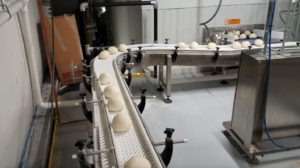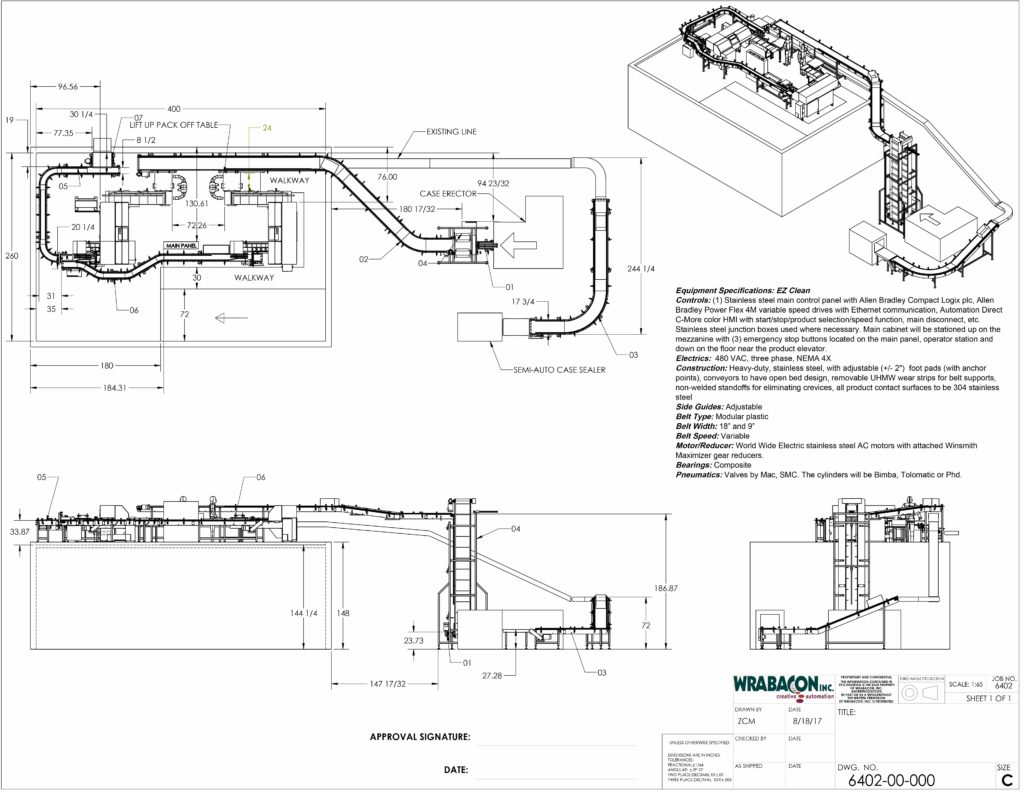The Challenge
 More efficient processes mean more profit. This was exactly the case with a food manufacturer that wanted to increase packaging production for their frozen dough balls. They turned to Wrabacon requesting a system design and install that would receive frozen dough balls from a freezer, singulate them (separate them into individual pieces), and transfer them to two automatic bagging machines. This one change would help them increase their production capabilities dramatically.
More efficient processes mean more profit. This was exactly the case with a food manufacturer that wanted to increase packaging production for their frozen dough balls. They turned to Wrabacon requesting a system design and install that would receive frozen dough balls from a freezer, singulate them (separate them into individual pieces), and transfer them to two automatic bagging machines. This one change would help them increase their production capabilities dramatically.
Once bagged, the sealed bags would need to be transferred to a manual packing area where the bags were hand packed into shipping cartons. The cases are formed and transferred to the pack off area via another series of conveyors and elevators. Once packed, the cases need to be transferred to the case taper and palletizing area.
The Wrabacon Solution
We carefully examined the situation and developed a solution that achieves their production goals while improving the efficiency of the entire process.
The dough balls will exit the freezer in rows of three or four across. After they transfer onto the first belt, they will then transfer 90 degrees onto a single lane take away conveyor. The dough balls will be singulated as they transfer 90 degrees. After singulation, the dough balls will travel around (2) 90 degree turn conveyors and will enter a diverter. The product diverter will divert the dough evenly into two lanes, one going to each bagger.
Each bagger has its own indexing bucket infeed conveyor. After diverting, the dough balls will travel downstream on two conveyors and will be traveling parallel to the bucket infeed conveyors. An escapement device will release one dough ball at a time from the accumulation, which will be stopped and pushed into the bucket of the indexing infeed conveyor. The dough ball will then be bagged and wrapped. A “load complete” signal will be sent to the bagger and a “ready to load” signal will be received from the bagger during the operation. The dough balls will exit the baggers and will be deposited onto a packing table where they will be manually removed and placed into empty cases.
Wrabacon’s solution also ensured that if the first bagger stops working, all of the product will be sent to the second bagger, with the operators manually removing the excess dough balls from the line. If the second bagger stops, the diverter will continue to divert the product evenly, and the excess dough balls going to the second bagger will be diverted off the line using a pneumatic guide.
For the final steps, the empty cases are erected on the main floor and discharged onto a short conveyor, which brings the empty cases to a vertical elevator. The elevator lifts the cases to the required elevation, pushes them off onto a ceiling hung conveyor. They are then conveyed to the operators for manual removal. The empty case conveyor has an end stop where the cases will accumulate. A backup sensor located on the conveyor (fed to the case erector) determines how many cases will be accumulated. The operators manually remove an empty case and place it onto a static loading station. They manually load the case and when finished, push it onto the takeaway conveyor that declines down into the packing room, where it will enter a case sealer and will then be manually palletized.
As part of this proposal, Wrabacon supplied the following components:
- Installation Assistance
- Knife edge freezer exit conveyor
- 180 degree product conveyor to bagger #1
- Product diverter
- Bagger #2 conveyor
- (2) product accumulation area with pneumatic pusher to load baggers
- (2) static bagging table
- Elevator feed conveyor
- Product elevator
- Empty case conveyor
- Full case conveyor from existing decline to case taper
- Control system
